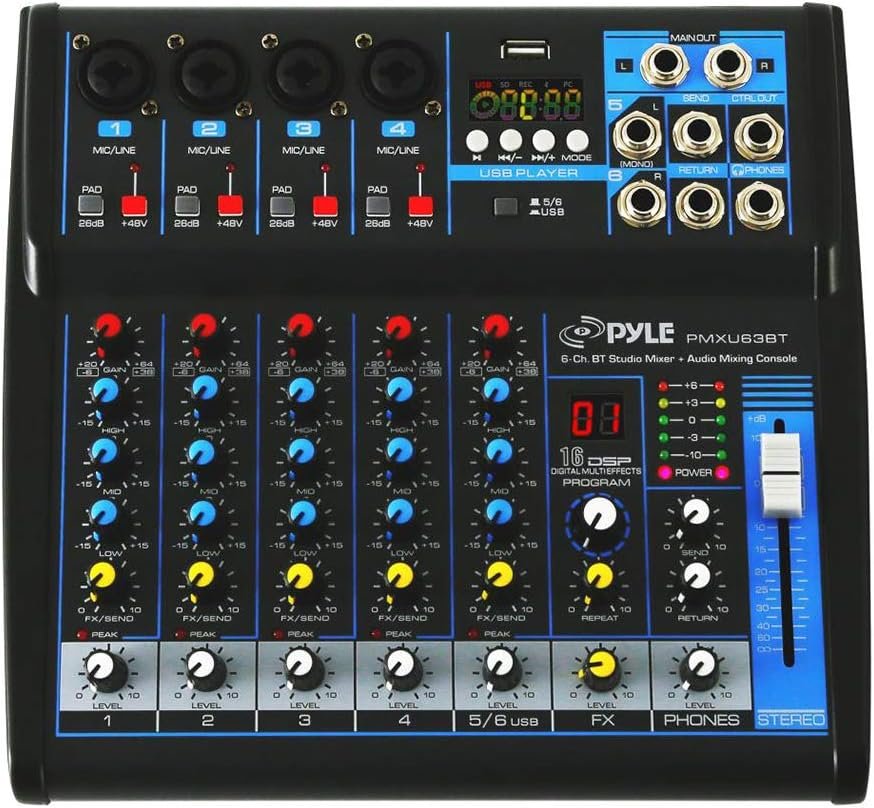Pyle 6-Channel Sound Mixer Review: Affordable Power for New Podcasters
Welcome back to Test Talk, where we normally cover tools, tech, and gear for the everyday builder — but today, we’re diving into audio. Specifically, the Pyle 6-channel sound mixing board I used to launch my podcast in early 2023.

If you’re starting out and want something that won’t break the bank but still sounds clean, this is the board I grabbed — and I’ve used it for every episode since day one.
Why I Bought This Mixer
- 🎙️ Needed 2+ mic inputs with phantom power (check)
- 🔊 Wanted clean sound without post-editing nightmares
- 💻 Needed simple USB output to connect straight to Audacity
- 🎧 Required headphone monitoring without lag
- 💰 Budget was under $120
This thing checked every box, and I still think it’s one of the best values out there if you’re launching a podcast or setting up a small home studio.
Setup: Plug and Play
I plugged in two XLR condenser mics, flipped on the 48v phantom power, connected it via USB to my PC, and opened up Audacity. That was it.
No latency, no weird hum, and the built-in EQ let me get a rich sound without touching filters. If there was any static at all, I ran it through Adobe Podcast Enhance and it cleaned up instantly.
Favorite Features
- 🎚️ 6 Channels with gain, EQ, and level controls
- 🧠 Built-in effects (reverb, delay, echo) — simple but usable
- 📡 Bluetooth input for playing music or remote interviews
- 🔁 USB output makes it DAW-friendly (Audacity, GarageBand, etc.)
- 🎧 Headphone jack with its own volume knob
It feels like a professional board without needing to Google every knob. You’ll be tweaking levels like a seasoned audio engineer in about 15 minutes.
Important Caveat: Mono Output
The USB out is mono. That means if you’re using two mics, they’ll record as a single blended track. For 90% of beginners, that’s fine — but if you want to edit each voice separately in post, you’ll need an interface with multitrack output.
My Real-World Setup
- 2 XLR mics running into channels 1 & 2
- Laptop connected via USB
- Audio recording done in Audacity
- Post-edit cleanup in Adobe Podcast Enhance
I also sometimes use the Bluetooth input to play music intros or phone interviews — but you can’t use Bluetooth and USB output at the same time. Just something to keep in mind.
Build Quality + Size
This mixer isn’t huge. It fits on a desk, weighs under 4 lbs, and feels solid. Knobs are smooth, nothing feels loose, and the input/output jacks are sturdy enough to hold up to daily use.
Watch My Full Video Review
👉 [Embed your YouTube video here — ideally with a thumbnail or call-to-action above the fold]
Get It on Amazon
If you’re starting a podcast, streaming, or just want a clean way to run your audio rig — this is the board I recommend:
🔗 Pyle 6-Channel Audio Mixer with USB and Bluetooth
Final Verdict
Would I recommend it? 100%. I still use it weekly. It’s easy to use, affordable, and gets the job done with minimal setup.
If you’re looking for your first real mixer that won’t frustrate you — this is the one. Just plug in your gear and hit record.
Common Questions (FAQ)
- Can it power condenser mics? — Yes, with 48v phantom power.
- Does it work with Audacity? — Perfectly. Just plug in via USB.
- Is it good for streaming? — Absolutely. Add clean sound to any stream.
- Can I edit mics separately? — Not with USB. You’ll need a multitrack interface.
- Do I need drivers? — Nope. It’s plug-and-play on Windows and Mac.
Got questions or want to see me test something else? Drop a comment or message me.
Until next time — keep talking, keep testing.
— Mark LaPorte | Test Talk
